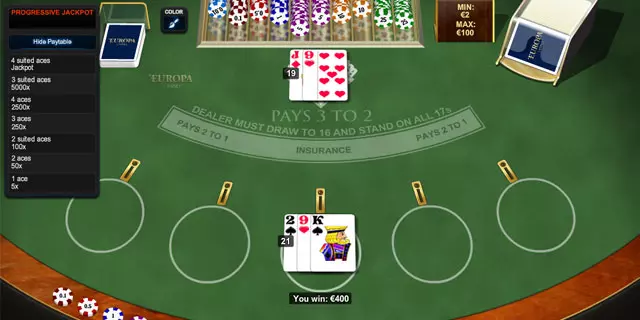Progressive Blackjack
Progressive Blackjack Offering Thrilling Side Bet Options
Adored by many, blackjack is a classic casino game that remains extremely popular with players. Thanks to its nature, the game allows them to influence the outcome to some extent, or at least reduce the house edge to the lowest possible rate. Nowadays, blackjack is available at almost any online casino, with different variations offering blackjack fans diverse gaming experiences. Nevertheless, strategic play remains one of the charms of the game, giving players the opportunity to tip the scales a bit more in their favor.
In addition to rule variations, different betting limits, and multiple betting hands, some blackjack games also feature exciting side bet options. To make things even more thrilling, some side bets can be linked to a progressive jackpot, allowing blackjack players to scoop amazing payouts. If you want to learn how to play progressive blackjack games and whether making this type of wager is worth it, we suggest you keep reading our detailed review of progressive blackjack.
-
 Sign Up Bonus
Sign Up Bonus
Up to $500
400% Bonus!9.7 -
 Sign Up Bonus
Sign Up Bonus
Up to $3500
350% Bonus!9.4 -
 Sign Up Bonus
Sign Up Bonus
Up to $2000
200% Bonus!9.3
Overview
Progressive blackjack variations are among the most exciting casino games because they give players a unique opportunity to win big money. The main difference between the classic game and its progressive counterparts is that the latter feature massive jackpots that increase every time someone plays a given progressive blackjack title and does not win the pot.
Whenever a player wins the entire jackpot amount, it resets to a predetermined sum that grows until someone gets lucky again. Usually, online casinos don’t impose any restrictions on the amount that the progressive jackpot can reach. To qualify for the progressive jackpot, players have to select a progressive blackjack variation and place a bet.
Progressive Blackjack Rules & Gameplay
Progressive blackjack variations follow the same rules as classic blackjack. You pit your wits against a dealer and your main objective is to beat the dealer’s hand. Your first priority should be to form a strong hand whose total is as close to twenty-one as possible if you wish to win. Another way to win is when the dealer busts—in other words, when the total value of the dealer’s hand exceeds twenty-one. If you go over this number, you lose automatically.
In progressive blackjack games, just like in the classic game, your initial options are to either hit or stand. If you choose to hit, you are dealt one more card, but if you stand, your total remains the same. It is also possible to double down or split a pair. In progressive blackjack variations, you can double down by placing a bet that is equal to your initial wager. Some variations allow you to perform this move after splitting. However, you are not permitted to double down if you have blackjack. Moreover, some progressive blackjack variants allow players to double down only when their hands total 9, 10, or 11.

Screenshot of Progressive Blackjack by Playtech
Usually, in progressive blackjack games, you are allowed to split any two identical cards, including aces. However, you are not allowed to re-split if you play Progressive Blackjack. You have the chance to take insurance when the dealer is showing an ace, but you are not allowed to surrender at any time. As for the dealer’s play, they must stand on all 17s.
Progressive Blackjack Strategy Chart
Rules:
- 4 Decks
- Dealer Stands on Soft 17
- Dealer Does Not Peek for Blackjack
- Double on Hard 9-11, No Double After Split (No DAS)
| Strategy Chart | |||||||||||
|---|---|---|---|---|---|---|---|---|---|---|---|
| Your Hand | The up card of the dealer | ||||||||||
| 2 | 3 | 4 | 5 | 6 | 7 | 8 | 9 | 10 | A | ||
| 5-7 | H | H | H | H | H | H | H | H | H | H | |
| 8 | H | H | H | H | H | H | H | H | H | H | |
| 9 | H | D | D | D | D | H | H | H | H | H | |
| 10 | D | D | D | D | D | D | D | D | H | H | |
| 11 | D | D | D | D | D | D | D | D | H | H | |
| 12 | H | H | S | S | S | H | H | H | H | H | |
| 13-16 | S | S | S | S | S | H | H | H | H | H | |
| 17+ | S | S | S | S | S | S | S | S | S | S | |
| A,2-A,6 | H | H | H | H | H | H | H | H | H | H | |
| A,7 | S | S | S | S | S | S | S | H | H | H | |
| A,8-A,9 | S | S | S | S | S | S | S | S | S | S | |
| 2,2; 3,3 | H | H | P | P | P | P | H | H | H | H | |
| 4,4 | H | H | H | H | H | H | H | H | H | H | |
| 5,5 | D | D | D | D | D | D | D | D | H | H | |
| 6,6 | H | P | P | P | P | H | H | H | H | H | |
| 7,7 | P | P | P | P | P | P | H | H | H | H | |
| 8,8 | P | P | P | P | P | P | P | P | H | H | |
| 9,9 | P | P | P | P | P | S | P | P | S | S | |
| 10,10 | S | S | S | S | S | S | S | S | S | S | |
| A,A | P | P | P | P | P | P | P | P | P | H | |
Legend:
- H: Hit
- H*: Hit with 2 cards, Stand with 3+ cards
- S: Stand
- D: Double if possible, otherwise hit
- P: Split (Pair)
Progressive Blackjack by Playtech
One of the most popular progressive blackjack variations is courtesy of Playtech. It uses six standard decks of 52 playing cards. At the beginning of every round, you are required to place your main bet. After that, you are dealt two face-up cards, while the dealer receives one face-up and one face-down card. The card that is not visible to the players is often referred to as the hole card.
In Progressive Blackjack by Playtech, you have the opportunity to win big by placing a side bet that is separate from your original wager. Of course, you are not obliged to make this bet, and it is entirely up to you to decide whether you would like the chance to win the progressive jackpot. Usually, the amount you are required to wager for this side bet is $1. The size of your wager is divided into two parts, both of which contribute to the progressive jackpot in different ways.
A large portion of your side bet goes to the current jackpot, which increases automatically. This is why progressive jackpot games usually feature a substantial sum that grows rapidly over short periods of time. The other part goes to the “seed” — in other words, it contributes to the initial amount from which the progressive jackpot starts building up.
When it comes to side bets, it should be noted that their payout can vary depending on the particular casino and the version. Perhaps because the ace is the most powerful card in the deck, it plays a crucial role in progressive blackjack games. In general, the more aces you manage to collect, the bigger your profit will be. It is clear that the payout also depends on how many aces you have.
Most online casinos pay out 5:1 if you have one ace, which is the smallest profit you can make with this side bet. If you get two aces, the payout is 50:1. This means that by placing this optional side bet of $1, you have the opportunity to win $50. The payout for three aces, regardless of their suit, is 250:1, and for four aces — 2,500:1.
Since your chances of getting aces of the same suit are much lower than receiving two of different suits, the payout for this type of combination is more generous. If you are dealt two aces of the same suit, you will get $100, provided that you have placed the $1 side bet. For three suited aces, the payout is quite impressive – 5,000:1, which makes this optional bet well worth considering.
Triple Sevens Blackjack
Microgaming is the company behind one of the most popular progressive jackpot blackjack titles, Triple Sevens Blackjack. The game uses 5 standard decks, each consisting of 52 playing cards. At first glance, this blackjack variation follows the standard rules of the game—players have to create a hand totaling as close to 21 as possible without going over this number. To start playing Triple Sevens Blackjack, you have to place your bet.
The most noteworthy aspect of the game is the progressive jackpot it offers. Blackjack fans should be informed that they need to place a side bet of $1 to play for the big prize. As the name of the game implies, players need to collect three 7s to win the progressive jackpot or a portion of it. Let us look at the payouts associated with the progressive side bet:
- The payout for any 7 is $5
- For two unsuited 7s, players win $25
- If the two 7s are suited, the payout is $50
- Three unsuited 7s come with a payout of $250
- For three suited sevens of clubs, hearts, or spades, the payout is $1,000
- To hit the progressive jackpot, players need to collect three 7s of diamonds
The house edge associated with the progressive side bet climbs to 16.2%. This progressive jackpot variation allows players to double down. The catch here is that this option is available only on totals of 9, 10, or 11. Splitting and resplitting are also allowed, but the latter option is available only once. Insurance is also an option, and the bet offers a payout of 2:1. Another important thing to consider is that the payout for hitting a blackjack is 3:2. As for the dealer’s play, they have to stand on all 17s. As you already know, this rule works in favor of the player.
WGS Technology’s Progressive Blackjack
Even though WGS Technology is not among the most popular names in the industry, the software company made a splash with the release of its Progressive Blackjack. It is played with 4 decks of cards. WGS Technology’s Progressive Blackjack is based on the fundamental rules of the game. To add extra excitement to the gameplay, the developers decided to include a progressive jackpot game. Players can place an optional side bet worth $1 to compete for the big prize. Similar to Playtech’s Progressive Blackjack, players have to collect aces. The progressive jackpot side bet offers the following payouts:
- For two aces of any suit, the payout is $25
- If you get two suited aces, you will pocket $50
- Three aces of any suit will boost your bankroll with $250
- Three aces of the same suit pay $2,500
- Assuming that you have four aces of any suit, you will collect 10% of the progressive jackpot
- For four suited aces, you will collect the progressive jackpot
Many amateur blackjack fans who are after big wins prefer to play WGS Technology’s Progressive Blackjack as it offers a relatively low house edge for the progressive side bet, more precisely 4.9%. The following rules stack the odds in favor of the player:
- The game uses 4 decks of cards
- The dealer stands on all 17s
- Naturals pay 3:1
This progressive blackjack variation allows players to take insurance that pays 2:1. It is important to inform our readers that doubling down is also an option, but only on totals of 9, 10, and 11. A rule that favors the house is that splitting is allowed only once.
Important Considerations
If you decide to play a blackjack game that features a progressive jackpot, there are a few important things to consider. First of all, the house edge associated with progressive side bets is higher. Therefore, your chances of winning are lower compared to playing classic blackjack. Of course, you can apply your strategy with the same success during the base game, and it will be just as effective as if you were playing the traditional version.
It is worth reminding you that you have the chance to win a progressive jackpot only if you place the respective side bet. When it comes to this optional bet, many players are rather skeptical and refrain from placing it, as they believe that they stand no chance of winning. While it is true that it is very hard to get four suited aces—or the respective hand needed to win the progressive jackpot—it should be noted that it is not impossible.
Conclusion
Progressive blackjack variations are among the most thrilling games that you can find at numerous online casinos. The reason why they appeal to so many players worldwide is that progressive blackjack variants provide them with the opportunity to win a substantial sum by playing their favorite casino game. All you need to do is simply place the respective side bet and hope for the best.
In the meantime, you can enjoy blackjack as usual and concentrate on beating the dealer. Bear in mind that if you want to make the most of every game, it is essential to use a strategy and apply it throughout the session. If you make decisions based solely on your gut feeling, you will most likely end up losing in the long run.
FAQ: Progressive Blackjack
Progressive Blackjack differentiates itself with the addition of a progressive jackpot, which grows every time the game is played and the jackpot is not won. This feature offers players the chance to win substantial payouts beyond regular blackjack wins, by placing a side bet in addition to the main game wager.
To qualify for the progressive jackpot in Progressive Blackjack, players must place a specific side bet, usually set at a standard amount like $1. Keep in mind that depending on the game’s provider, the side bet’s amount may differ. This additional bet is separate from the main blackjack wager and is linked to hitting specific card combinations, often involving aces, that trigger the jackpot or a portion of it.
While the basic rules in progressive variations mirror classic blackjack, including aiming for a hand value as close to 21 as possible without busting, Progressive Blackjack may feature rule deviations linked to the ability to split, double down on certain hand values, and restrictions on re-splitting. The dealer typically stands on all 17s, and specific rules about splitting aces and the payouts for different ace combinations are key.
Payouts for the side bet in Progressive Blackjack vary depending on the combination of aces. For example, a single ace might pay 5:1, two aces 50:1, three aces 250:1, and four aces could pay 2,500:1. Suited aces or specific combinations may offer higher payouts, and hitting four suited aces could win the entire progressive jackpot.
Players should consider the higher house edge associated with the progressive side bet, as it typically offers lower chances of winning compared to the main blackjack game. Despite the allure of a large jackpot, the side bet requires a strategic approach to balance the excitement of potentially huge wins with the overall cost to the player’s bankroll.


